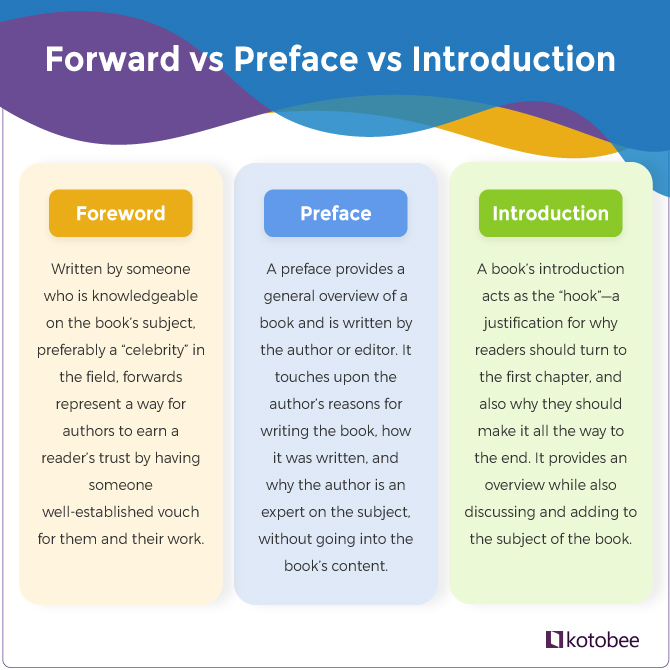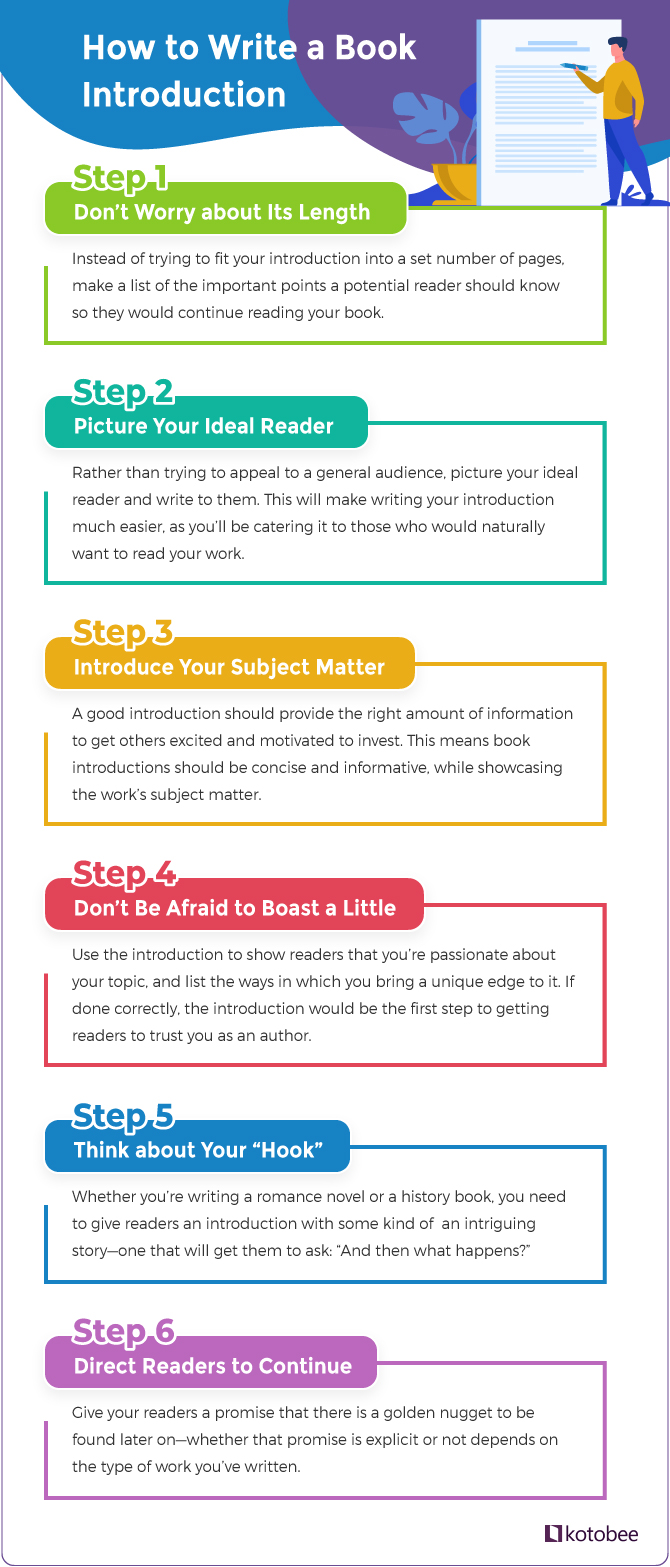How to Write the Best Book Introduction (With Checklists & Examples)
Readers might be intrigued by a book standing in the middle of a bookstore lined with shiny artwork. But what will make them flip through the pages after they’ve picked it up? And what will lead them to the cashier to make a commitment to this one book out of countless others? The answer lies in the ‘book introduction’. That’s where the real magic happens: where the author hooks the reader and captures their thoughts, making them feel like what they’re about to read is going to change their life in some way.
In this article, we are going to cover the purpose of book introductions; the simple steps you can take to write a great one for your book (whether it’s for a work of fiction or nonfiction); and finally, we’ll share some examples by authors who just nailed the assignment!

In this article:
- What is a book introduction exactly?
- Why you need a book introduction
- How to write a book introduction that people will actually read
- Fiction book introduction checklist (downloadable)
- Non-fiction book introduction checklist (downloadable)
- Examples of great book introductions (fiction and non-fiction)
Forward VS Preface Vs Introduction
There are many different elements that make up the “front matter” of a book, or the pages preceding the body. We’ve all come across introductions, forewords, and prefaces, and sometimes a book can have a mix of all three. So first, let’s establish the differences between them.
Foreword
Forewords are usually not written by the author or editor, but rather by someone who is knowledgeable on the book’s subject—preferably a “celebrity” in the field. Forewords represent a way for authors to earn readers’ trust by having someone well-established vouch for these authors and their work. And usually, they are no more than a couple of pages long—just like a letter of reference.
Preface
A preface provides a general overview of a book and is written by the author or editor. It touches upon the author’s reasons for writing the book, how it is written, and why the author is an expert on the subject. What it doesn’t do, however, is offer a close examination of the book’s contents. Think of a preface as the “why” and “how” of a work, but not the “what.”
Introduction
A book’s introduction, on the other hand, can provide the same overview that a preface does, while also discussing and adding to the subject of the book. It is written by the author and usually offers readers an outline of the book’s contents, letting the readers know what’s to come. In effect, it acts as the “hook”—a justification for why readers should turn to the first chapter, and also why they should make it all the way to the end.

The Purpose of Book Introductions
Before we get into how to write a fantastic book introduction, here are five glorious things that a well-written introduction can do for you:
1. Getting Readers Hooked
Has your book been picked up at a bookstore? Great! The potential buyer is now scanning the first paragraph of your introduction. They’re about to keep flipping through the pages, when, slowly, they pause. Something in that paragraph has caught their attention and they’re now putting down their bag for a minute. That’s the hook.
2. Convincing Them to Carry On
Not only will a good introduction convince the reader to turn to the next chapter, but it will also give them a sense of wanting to know what’s to come much later on. With the right amount of show-and-tell, your introduction will persuade them that this book is one they should not put away till the end.
3. Increasing Book Sales
The book industry is a competitive one, and it’s no secret that it takes a lot to market and sell a book. But whether you have a publishing contract or are planning to self-publish, your introduction is one of the most vital sales tools your book will have. As the author, you know what your work has to offer, and with a good introduction, your readers will too.
4. Providing a Bite-Sized Version of Your Work
Reading a book—especially a novel or any other type of long-form work—is an investment on the reader’s part. The introduction is your chance to clearly summarize hundreds of pages in just a few.
In this way, you’re offering a “trailer” of your work—a bite-sized version that potential readers can quickly digest in order to make the decision to finish reading your book.
5. Displaying Your Expertise
It doesn’t matter if you’re writing about a niche subject or something that’s been written about thousands of times; either way, you have to convince your readers that you know what you are talking about.
The introduction is a chance to showcase your talents, whether it’s by writing that perfect opening to your mystery novel, or by outlining the research methodology for your book on ancient Egyptian architecture.

How to Write a Book Introduction
Now that you know how important a book introduction is, it’s time to know how it’s done. In this section, we will provide a step-by-step guide on how to nail yours, and also give you some more specific pointers on how to write introductions for works of fiction and non-fiction.
Step 1: Don’t Worry about Its Length
It’s normal to wonder if there’s a word limit you should stick to when writing your introduction. The short answer is: there isn’t one. The length of an introduction entirely depends on your subject matter. In other words, how much does the reader need to know about your topic before being convinced to make that purchase?
So instead of trying to fit your introduction into a set number of pages, make a list of the important points a potential reader should know so they would continue reading your book. Using that as your guide, you’ll be able to naturally determine the appropriate length of your introduction as you write it.
Step 2: Choose Your Reader Wisely
Choosing your reader may sound strange, but before an author begins writing, he/she will usually have an ideal reader persona in mind. This reader is one who is interested in your subject, and who will therefore appreciate the work you have done.
Before writing your introduction, picture your ideal reader and write to them rather than trying to appeal to a general audience. This will make writing your introduction much easier, as you will be catering it to those who would naturally want to read your work.
Step 3: Introduce Your Subject Matter
A good introduction is like a good sales pitch; it should provide the right amount of information to get others excited and motivated to invest. This means book introductions should be concise and informative while showcasing the work’s subject matter.
Here are three questions to consider:
- Why is this topic important?
- Why should people read about it now?
- What are the main things you promise the reader will take away from this reading experience?
Step 4: Don’t Be Afraid to Boast a Little
The introduction is not the place for you to be humble about your experiences and expertise. Of course, this doesn’t mean you should use it just to show off and sing your own praises either. Instead, you have to find the right balance between making yourself relatable to your readers, while simultaneously demonstrating that you are an authority on your subject.
Use the introduction to show readers that you’re passionate about your topic, and list the ways in which you bring a unique edge to it. If done correctly, the introduction would be the first step to getting readers to trust you as an author.
Step 5: Think about Your “Hook”
Now that you have your ideal reader, outline, and expertise all down, it’s time to think about your introduction’s opening paragraph. How are you going to get that reader to pause in the middle of the bookstore? How will you get them to instantly stop skimming and start carefully reading instead?
That’s where your “hook” comes in. Whether you’re writing a romance novel or a history book, you need to give readers an introduction with some kind of an intriguing story—one that will get them to ask: “And then what happens next?”
Step 6: Direct Readers to Continue
So far you’ve nailed the opening and the core of your introduction, and your reader is looking forward to moving on to the next page. Great work. Now it’s time to wrap up your introduction in a way that prompts readers to get to the end of the book.
How do you do that? You give them a promise that there is a golden nugget to be found later on—whether that promise is explicit or not depends on the type of work you’ve written.
For example, if you’re writing a work of non-fiction, you can intrigue your readers by hinting at the conclusions they’ll attain by the end of the book. And if you’re working on an introduction to a novel, you can use foreshadowing to keep readers hungry for the climax that is yet to come.

Introduction for Fiction Books Checklist
The steps provided above will work for any type of book introduction. Nevertheless, here are some additional tips that are specific to fiction book introductions.
For the purpose of this section, we have chosen novels as an example of works of fiction. For each tip, we’ve put together a list of questions for you to check off while writing to make sure your introduction is airtight.
1. Establishing the Setting and Mood
- Where and in what time period is the novel set?
- Does your introduction give readers a strong sense of this setting?
- Is it clear what the general mood of the story is? (Is it dark? Mysterious? Romantic?)
- What details did you use in your introduction to convey this mood?
2. Indicating Your Narrator
- Who is the narrator in your novel? Is it one of the characters? Or are you using a third-person omniscient or third-person limited narrator?
- What kind of tone does your narrator adopt?
- Does your narrator’s voice effectively draw in the reader?
3. Introducing Your Characters
- Have you introduced at least one of your main characters in the introduction?
- How does your introduction make that character memorable?
4. Showing or Foreshadowing the Main Conflict
- Does your introduction hint at the novel’s main conflict?
- Is the conflict “juicy” enough to make readers want to read on?
- Does your introduction give the readers a sense of how the conflict will affect the main character(s)?
5. Exhibiting or Hinting at the Main Themes
- Can the readers attain an overview of the novel’s potential themes through your introduction?
- Does the introduction effectively use the literary elements of setting, plot, conflict, and foreshadowing to establish the main themes of the novel?
6. Hooking the Reader
- Does the introduction leave readers with the question: “What happens next?”
Introduction for Nonfiction Books Checklist
A good nonfiction introduction will aim to capture the reader’s mind just like a good fiction introduction would. Below is a list of tips and questions tailored specifically to suit works of nonfiction. In this case, we’ll use a standard academic monograph as an example.
1. Introducing the Topic
- Does the introduction dive straight into the book’s main subject matter?
- Does the reader know what he/she can expect to learn from this book?
- Is it made clear why this topic is relevant and important?
2. Outlining the Content
- Does the introduction provide a clear outline of what each chapter will discuss?
- Does it provide enough information about the book’s research methodology?
3. Asserting the Author’s Credibility
- Does the introduction justify why you, as the author are an authority on the subject matter discussed?
- Is the tone of the introduction assertive but also inviting, such that readers can feel a sense of trust and relatability?
4. Identifying a Problem
- Does the introduction present a problem that the readers can relate to?
- Does it clearly demonstrate the effects of that problem on our world today?
5. Making a Promise to the Reader
- Does the introduction motivate readers by making a promise to provide answers throughout the book?
- Is this promise crafted in a way that makes readers want to reach the conclusion of the book?
6. Showing Your Passion
- Does the introduction effectively convey your passion for your subject matter?
- Does it allow readers to see how important the topic is to you?
- Do you demonstrate a personal connection to your subject matter?
Book Introduction Examples
You now have all the necessary tools to write that winning introduction. All that’s left now is some inspiration to get you going. Below are four samples from great introductions that are sure to help: two from nonfiction titles, and two from works of fiction.
On Identity by Amin Maalouf [Nonfiction]
The very first line of this introduction instantly conveys the author’s frustrated tone: “How many times” has he been asked to pick a side: French or Lebanese? The expressed frustration makes the author appear “human”, relatable. The reader is also immediately acquainted with the author’s problem: Who is he in the midst of all the languages and cultural traditions he has been exposed to over the years? And why must he choose just one “identity” and stick to it?
Maalouf’s introduction is also riddled with rhetorical questions that engage the reader, allowing them to question their own views, too. “Would I exist more authentically if I cut off a part of myself?” The reader becomes invested in the author’s struggle—probably because Maalouf’s ideal reader is someone who, like him, has questions about their identity in the face of multiculturalism.
What makes this introduction great is that despite the fact that Maalouf is evidently frustrated, he already has the solution: he is both Lebanese and American, and he is sure of it because “any other answer would be a lie.” The reader, therefore, trusts that Maalouf has already figured it out, and that his book will show exactly how he reached this conclusion.
Despite Maalouf’s frustration, which is there to mimic the reader’s own feelings of confusion, there is a promise of resolution that is yet to come. And thus the reader wants to carry on.
And Still the Music Plays by Graham Stokes [Nonfiction]
The power of this introduction stems from three main elements. Firstly, the author uses the very first line to explicitly state his reason for writing this book; namely, his “increasing wish to say more” about the effects of dementia on people’s lives.
Secondly, the author gives important background information about dementia and in doing so, sets out the main problem: that neuropathology has failed to explain certain important aspects of the disease. The author then shows how his book aims to provide a solution, which is by adopting a research methodology that focuses on the everyday experiences of people with dementia: “the ‘person-centered’ model.”
However, Stokes doesn’t get into the details of his method just yet; instead, he appeals to the reader’s sensibilities by adopting an empathetic tone towards his subject matter and making it relatable: “They were like you and me, and then seemingly inexplicably they were struck down.” The author directly addresses his ideal reader, “you,” and hooks them almost as if they don’t have a choice.
Finally, if the author were pitching this book to publishers, he would probably use the last sentence in the introduction’s second paragraph as his tagline: “Extraordinary stories about ordinary people.” Sold!
To Kill a Mockingbird by Harper Lee [Fiction]
It’s no surprise that Harper Lee’s To Kill a Mockingbird has been a part of many school curricula for years. What makes the opening of this novel brilliant is how the author manages to effortlessly throw the reader into the heart of the action. Through a flashback to a single event—Jem’s arm injury—the reader is given plenty of information about the setting (the American South), the narrator (Jem’s younger sister), and so many important characters, including Jem, Atticus, and Boo Radley.
Although it may initially seem overwhelming, the author is not simply rattling off a bunch of character names. Instead, she subtly hints at the mystery behind them. Who are the Ewells, and what role did they play in Jem’s accident? Who is Boo Radley, and what does it mean to have him “come out”? What is the significance of Simon Finch’s paddling up the Alabama river? These are all questions that will run through the reader’s mind, and the only way to get answers is to read on.
The art here lies in how the author uses the single occurrence of Jem’s accident to neatly tie together a complex story about racial prejudice and injustice. Thus, the reader is told to anticipate the novel’s climax, and to continue reading in order to find out how it happens.
The Yellow Wallpaper by Charlotte Perkins Gilman [Fiction]
The strength of this short story’s introduction lies in the simple, conversational way in which it reveals a whole lot of information. From the outset, we immediately find out a number of key things:
- The setting: The narrator and her husband are spending the summer away at a mansion.
- The mood: There is something eerie and mysterious about this place that has been let so cheaply and previously left unoccupied for so long.
- The conflict: The narrator is unwell and seems to be afraid to voice her thoughts out loud to her husband.
Talk about conciseness! Every word in Gilman’s introduction is packed with meaning and has an intentional purpose. The narrator and her husband’s tense relationship is immediately brought to the reader’s attention via the simple line: “but one expects that in marriage.” It’s almost like the narrator has given up on the entire institution.
The first-person narration serves to draw readers in, making them feel close to the protagonist and her point of view. Not only that, but the secrecy of the narrator’s writing (“I would not say it to a living soul”) conveys the sense of reading someone’s diary, or perhaps a secret letter, thus immersing the reader in this writer’s world.
Gilman’s introduction succinctly and masterfully draws readers in, making them already start to empathize with—or at least express interest in—her main character’s story.
Concluding Thoughts
It doesn’t matter if you’re working on the next bestselling novel, or on a book about birds of the Middle East—a well-crafted introduction is your book’s golden ticket. It’s a powerful sales tool and a great hook for people to keep reading your book, and now you have all the information you need to use it effectively.
Your ideal reader is out there, and a great introduction will convince them that yours is the book they should be taking home. All you have to do is start writing!
.
Read More
Making Use of Humor in Writing: Why and How
Best AI Writing Software in 2025
Top Plagiarism Checkers and Tools of 2025 [Compared]
















Justin Allen
July 12, 2023Thanks for sharing the blog. I am a Ph.D. student and also have an interest in writing. I will consider the information when I publish my first book.
Kotobee
September 10, 2023Hi Justin,
You’re very welcome! We’re delighted to hear that you found our article helpful, especially as you pursue your Ph.D. and your interest in writing.
When you’re ready to publish your first book, feel free to revisit our resources or reach out if you have any questions or need guidance.
We wish you the best of luck with your academic and writing endeavors! 🙂
kario
May 27, 2024They write a good blog.
Kotobee
May 28, 2024Thanks Kario for your kind words! 🙂
Smith Brown
July 26, 2024Nice Post thank you So much
Kotobee
August 6, 2024Hi Smith!
We are glad you liked this post 🙂
Saairatechnologies
January 3, 2025it is very interesting.thanks
Bri
March 1, 2025I appreciate this well-written guide. I found several ideas for my introduction. I would love a little more input for a daily devotional. Maybe you can add something specific for that some time soon.
Thanks again.
emmalilly
March 5, 2025They write a good and informative blog.
geometry dash lite
November 17, 2025The emphasis on the book introduction’s role in captivating readers is spot on. It’s like the book’s opening act, setting the stage for what’s to come. Crafting a compelling introduction isn’t just about summary; it’s about creating intrigue and connecting emotionally with readers. A well-crafted intro can indeed be the bridge that turns a browser into a committed reader.